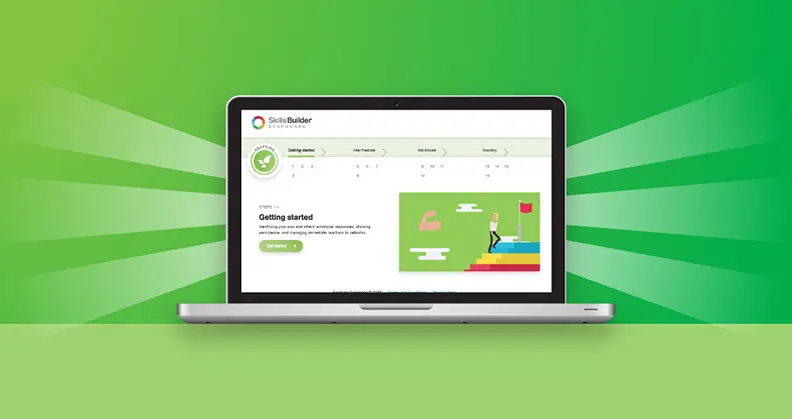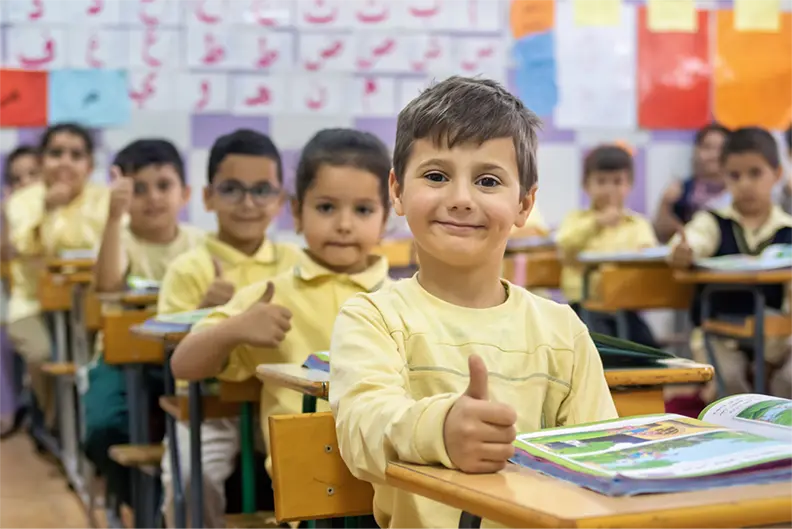Creativity skills are taking on ever increasing importance in the mind of employers. In 2020, creativity was ranked as the most in-demand skill for the second time in a row by Linkedin, appearing in over 20 million job ads. It will be one of the top three skills needed in the workplace by 2025, along with critical thinking and complex problem-solving – the partner components of creativity. Given creativity’s position as an essential employability skill, those who focus on building creativity skills are set to gain in the future labour market.
So here is an important question for you if you’re at the start of your career journey: how can you learn to be more creative?
At Skills Builder, we challenge the idea that creativity is some intangible talent that cannot be learnt or developed – rather, it’s a skill that can be defined, built and enhanced. So let’s start with that definition:
Defining creativity skills
Creativity is one of the eight essential skills that support anyone to reach their full potential. We define creativity skills as the ‘use of imagination and the generation of new ideas’.
Those entering the workplace today are faced with a plethora of challenges from rapidly evolving technology to automation and AI. There’s a growing need for individuals who can think creatively, generate new ideas, and find innovative solutions to complex problems to face these emerging challenges. Creativity as a skill also enables you to tackle challenges outside of work and allows you to be adaptable and resilient to the challenges of the modern world in which we live.
Build creativity skills
With the Universal Framework, the definition of a skill is only the starting point for success. When you’re thinking about how to meaningfully build the skill of creativity, the Framework breaks it down into 16 logical, easy to understand learning steps that guide you to improve your creativity skills from a beginner, to mastery of creative thinking.
While we often treat our work and our wider lives as two completely separate entities, without any overlap, when it comes to creativity we should make the most of our ideas in both ‘spaces’. Creativity can be more successful when you can shift ideas and ways of thinking from one scenario to the other – inspiration can cut across both those areas if we spot it. So let’s explore some of the specific things you can do to build creativity:
Developing ideas using mindmaps
A mindmap is a simple creative tool to explore a particular idea. Mindmapping takes a central concept and builds off ideas from it. Major ideas are connected directly to the central concept, and other ideas branch out from those major ideas. This process gives individuals creative agency to consider a whole range of ideas and solutions that may contribute towards the central concept. The mindmap can then be used as a basis from which to select the best ideas that have come out of the brainstorming by allowing the individual to reflect on each suggestion and analyse whether it is an idea that should be taken forward.
To construct your own mindmap to enable creative thinking:
- Start with a single theme or question in the middle of the page
- Jot down initial ideas from that stimulus and fan out
- Draw lines between the ideas to show how they’re linked
- There might also be further ideas or connections that come from those ideas, and links between them can also be linked with arrows.
Mindmaps are a universally popular tool because they are quick to use, adaptable, sharable and support working together. As such, they are a really practical method of generating ideas that you can share with your peers at work, for example when thinking about new options, or to share with your manager to justify your thinking.
In your personal life this can be an interesting way to get creative too. You might be thinking about taking up a new hobby, finding ways to create a better routine, or making something at home – mindmapping can help to think about the whole range of options you might not have thought about otherwise.
Improving ideas through open and closed questioning
The creative process is always aided by asking effective questions. We can help ourselves go through the process to pre-empt the response that others will have to our ideas and will help us to consider whether there are other ways of reaching our goals too.
A big difference between those who have mastered creativity and those who are at an earlier stage is the willingness to ask challenging questions and be open to changing the idea to make it better.
These questions fall into two general categories:
- Open - those that cannot be answered with a ‘yes’ or ‘no’ response. For example, they tend to start with words like ‘who’, what’, ‘why’, ‘when’ and ‘how’.
- Closed - those that can generally be answered with a ‘yes’ or ‘no’ response. Examples include questions that start with ‘Is that…’ or ‘Did…’.
Though closed questions can be useful and effective, making use of open questions also gives way to broad creative thinking. Examples of open questions that aid the development of creative ideas include:
- How does this idea fit in with the brief?
- What could make this idea better?
- What would make this shorter / easier to use / more engaging / simpler to understand / more enjoyable?
- How will I know if this is an idea that will work in practice?
These types of questions will be useful starting out in your career, as well as at home. In the workplace, asking yourself these questions will help you to interrogate your own ideas, in turn, helping you to come up with more ideas and stretch your thinking. You might be asking yourself these questions at home, when thinking about how you can reach a specific personal goal, like making healthier choices or improving your fitness – and these same tactics can be brought into the workplace.
Making sense of different perspectives and using them to improve ideas
It’s true that good ideas often come from unexpected places – but when generating and developing ideas, it is easy to fall into the trap of doing that solely from our own perspective. Using questions can help you to capture different perspectives on your ideas. You could think about:
- Who else might end up being a user of your idea?
- In what ways might those individuals vary?
- Do they have different needs or success criteria?
- Are there changes that are needed to make an idea feasible for them?
- What changes might other people suggest to your idea, and why?
Once you have captured these different perspectives, it is important to prioritise effectively in order to achieve the best outcome. It is vital to consider what the most important priority is for the idea that you are developing. You can use open and closed questions also, to help you prioritise.
The effect of including others in your idea generation process can build trust and relationships at work, and can help with accountability at home too. For your employability skills, businesses are increasingly focused on ensuring that ideas are appropriately inclusive so relying on diverse perspectives will always be an asset as you seek to compromise effectively, or differentiate based on user needs.
Building creativity now: Getting started with benchmark
For individuals just starting out on this journey of creativity, the best place to start building the skill is by using our online tool, Benchmark. Completing a self-assessment will give you a picture of where your creative strengths and development areas are. From there, you can start to consider your direction of learning, perhaps by mindmapping, that you can take to build stronger creativity skills.






